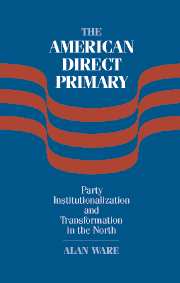Book contents
5 - Reformers versus Urban Machines?
Published online by Cambridge University Press: 16 July 2009
Summary
One common interpretation of the rapid rise of the direct primary is that it emanated from a conflict between reformers, usually based in cities and often antiparty in orientation, and urban political machines. On this view, as exemplified, for example, in the account presented by Steven J. Diner, Progressive legislation on institutional reform at the state level was an extension of these reformers' assaults on the power of urban bosses. Consequently, the introduction of the direct primary is usually portrayed as highly conflictual, with the major protagonists being antiparty reformers, on the one side, and the urban machines on the other. This view would seem to make sense. After all, it has already been seen that, at the end of the 1880s and in the 1890s, both in relation to the Australian Ballot and the legal regulation of party nominations, anxieties about the practices in the large urban areas were crucial in prompting legislation. But is this actually what happened?
If the account were accurate, it would be expected that such conflict would be most evident in the states containing the largest cities. It was there that the stakes would be highest for the party organizations, because of the benefits they could extract from control of local government; it was there also that the highest concentrations of the middle classes would be found, and it was these classes, on whom, relatively, the highest tax burdens tended to fall in the nineteenth century, that formed the main base of reform movements.
- Type
- Chapter
- Information
- The American Direct PrimaryParty Institutionalization and Transformation in the North, pp. 131 - 161Publisher: Cambridge University PressPrint publication year: 2002



